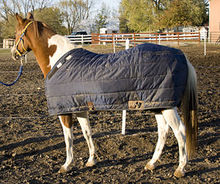Horses have two natural defenses against cold; a long hair coat and a layer of fat beneath the skin. Both provide an excellent means of insulation against the cold.

Horse in heavy winter blanket
Horses have two natural defenses against cold; a long hair coat and a layer of fat beneath the skin which provide an excellent means of insulation against the cold, but horse may need blankets depending on the situation.
The long winter hair coat serves as insulation by reducing the loss of body heat and provides the first line of defense against the cold. Its insulating value is lost when the horse becomes wet and/or is covered with mud.
This is why it is important to provide a dry sheltered area in cold wet weather and regular grooming. But, how do you know if you should blanket your horse or not?
Blanketing a horse is necessary to reduce the effects of cold and inclement weather when:
- There is no shelter available during turnout periods and the temperatures drop below 5 degrees F, or the wind chill is below 5 degrees F.
- There is a chance the horse will become wet (not usually a problem with snow, but much more of a problem with rain, ice, and/or freezing rain).
- The horse has had its winter coat clipped for showing.
- The horse is very young or very old.
- The horse has not been acclimated to the cold (i.e. recently relocated from a southern climate).
- The horse has a body condition score of 3 or less, or in poor health.
Blanket Fit
It is important that the blanket fit the horse make sure you have the correct size to fit the horse.
Horses can develop rub marks or sores where the straps securing the blanket fit improperly. If the horse is continuously blanketed the blanket should be removed regularly to inspected for damage and reposition due to twisting.
Make sure blankets are kept dry and do not put a blanket on a wet horse; wait until the horse is dry before blanketing. Or take a wet blanket off a horse to keep it from becoming chilled.
Days that the temperature becomes warm remove the blanket so the horse dose not sweat and become wet under the blanket. Air out the blanket and dry out the horse’s hair coat.
The equine hair coat acts as insulation by trapping air, however, if the hair is wet or full of mud, air is excluded, reducing its insulating value and increasing heat loss. As little as 0.1 inch of rain can cause cold stress by making the hair and reducing its insulating value. It is important to keep the horse dry and sheltered from rain. Wooly horses with a thicker hair coat can retain more heat …so sometimes it is better not to blanket.
Reference: Marcia Hathaway, October 2012, Univ. of Minn. Horse Newsletter
